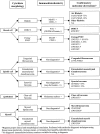Molecular genetics of pediatric soft tissue tumors: clinical application
- PMID: 12876204
- PMCID: PMC1907327
- DOI: 10.1016/S1525-1578(10)60466-7
Molecular genetics of pediatric soft tissue tumors: clinical application
Abstract
The application of molecular genetics to pediatric soft tissue tumors has grown tremendously over the last decade. It has resulted in the identification of novel genes that have provided us with an increased understanding of oncogenesis. Furthermore, these findings have identified diagnostic and potentially prognostic factors for patient management. Molecular diagnostic techniques, such as reverse transcription PCR (RT-PCR) and fluorescence in situ hybridization (FISH), have become important tools for evaluating pediatric soft tissue tumors. By detecting characteristic fusion genes, these techniques have greatly increased the diagnostic accuracy of histopathological classification. One of the exciting promises of the development of these molecular techniques is their ability to detect micrometastasis and minimal residual disease. Monitoring of minimal residual disease in pediatric soft tissue tumors by quantitative RT-PCR may provide important prognostic information. Furthermore, the potential development of targeted therapy based on the understanding of the molecular pathology of a specific soft tissue tumor may complement existing treatments and improve disease outcome.
Figures
Similar articles
-
Use of reverse transcriptase polymerase chain reaction for diagnosis and staging of alveolar rhabdomyosarcoma, Ewing sarcoma family of tumors, and desmoplastic small round cell tumor.J Pediatr Hematol Oncol. 2001 Feb;23(2):99-104. doi: 10.1097/00043426-200102000-00006. J Pediatr Hematol Oncol. 2001. PMID: 11216714
-
[Classification of soft tissue tumors and current approach to pathologic diagnosis].Rinsho Byori. 2010 Apr;58(4):352-7. Rinsho Byori. 2010. PMID: 20496763 Review. Japanese.
-
[Molecular pathology of soft tissue tumors: Contribution to diagnosis and therapy prediction].Pathologe. 2015 Mar;36(2):126-36. doi: 10.1007/s00292-015-0010-6. Pathologe. 2015. PMID: 25822596 Review. German.
-
[Contribution of molecular biology for better management of soft tissue tumors].Ann Pathol. 2012 Nov;32(5 Suppl):S103-7. doi: 10.1016/j.annpat.2012.07.014. Epub 2012 Oct 12. Ann Pathol. 2012. PMID: 23127923 French. No abstract available.
-
The clinical role of molecular genetics in soft tissue tumor pathology.Cancer Metastasis Rev. 1997 Jun;16(1-2):207-27. doi: 10.1023/a:1005721114555. Cancer Metastasis Rev. 1997. PMID: 9156287 Review.
Cited by
-
Pediatric cancer-pathology and microenvironment influence: a perspective into osteosarcoma and non-osteogenic mesenchymal malignant neoplasms.Discov Oncol. 2024 Aug 18;15(1):358. doi: 10.1007/s12672-024-01240-5. Discov Oncol. 2024. PMID: 39154307 Free PMC article. Review.
-
Scanning all chromosomal abnormalities with microarray-based comparative genomic hybridization in differential diagnosis of pediatric cancers.Int J Clin Exp Pathol. 2019 Aug 1;12(8):3140-3148. eCollection 2019. Int J Clin Exp Pathol. 2019. PMID: 31934157 Free PMC article.
-
Pathological diagnosis of paediatric tumours from image-guided needle core biopsies: a systematic review.Pediatr Radiol. 2006 May;36(5):426-31. doi: 10.1007/s00247-006-0123-4. Epub 2006 Mar 11. Pediatr Radiol. 2006. PMID: 16532346
-
Flow cytometry, molecular analysis, and other special techniques (in Serous Fluid Cytopathology).Cytojournal. 2022 Mar 19;19:18. doi: 10.25259/CMAS_02_13_2021. eCollection 2022. Cytojournal. 2022. PMID: 35510118 Free PMC article. Review.
-
Current concepts in the molecular genetics of pediatric brain tumors: implications for emerging therapies.Childs Nerv Syst. 2006 Nov;22(11):1379-94. doi: 10.1007/s00381-006-0187-3. Epub 2006 Sep 2. Childs Nerv Syst. 2006. PMID: 16951964 Review.
References
-
- Raney RB: Soft-tissue sarcoma in childhood and adolescence. Curr Oncol Rep 2002, 4:291-298 - PubMed
-
- Crist WM, Anderson JR, Meza JL, Fryer C, Raney RB, Ruymann FB, Breneman J, Qualman SJ, Wiener E, Wharam M, Lobe T, Webber B, Maurer HM, Donaldson SS: Intergroup rhabdomyosarcoma study-IV: results for patients with non-metastatic disease. J Clin Oncol 2001, 19:3091-3102 - PubMed
-
- Burdach S, Jurgens H: High-dose chemoradiotherapy (HDC) in the Ewing family of tumors (EFT). Crit Rev Oncol Hematol 2002, 41:169-189 - PubMed
-
- Pfeifer JD, Hill DA, O’Sullivan MJ, Dehner LP: Diagnostic gold standard for soft tissue tumours: morphology or molecular genetics? Histopathology 2000, 37:485-500 - PubMed
-
- Kilpatrick SE, Garvin AJ: Recent advances in the diagnosis of pediatric soft-tissue tumors. Med Pediatr Oncol 1999, 32:373-376 - PubMed
Publication types
MeSH terms
LinkOut - more resources
Full Text Sources
Other Literature Sources



